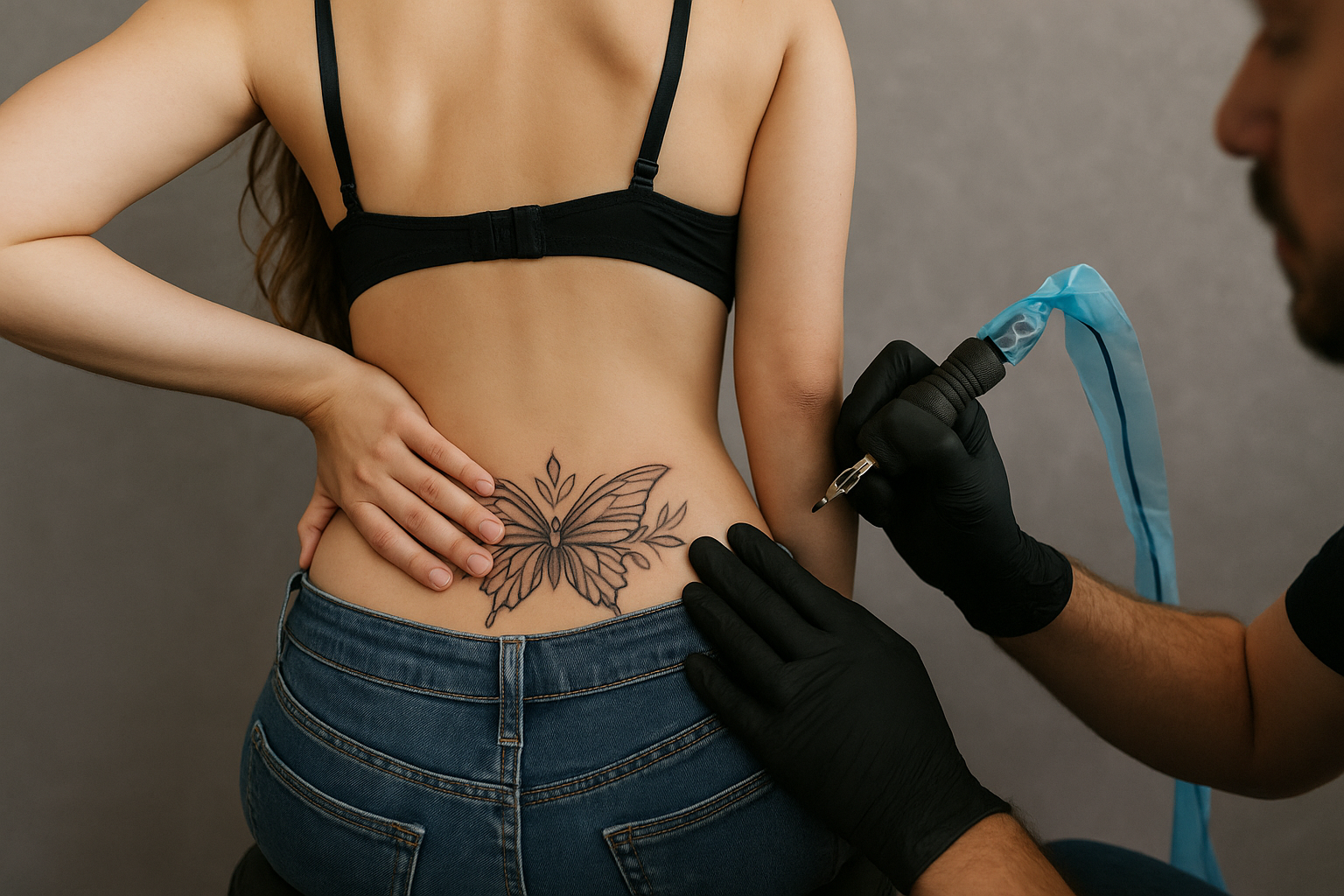Table of Contents
Getting a lower back tattoo isn’t just about choosing the right design. It’s about surrendering to the needle, feeling the burn, and learning to heal in one of the most movement-prone areas of your body. It’s sensual, intimate, and—let’s be honest—pretty damn painful.
But it’s also worth it.
Whether you’re considering your first tattoo or you’re already inked and curious about what makes this spot so unique, this guide breaks down everything you need to know about getting a tattoo on your lower back: pain levels, healing hacks, clothing tips, recovery time, and what it really feels like—mentally and physically.
Let’s strip it down to the skin.
1. Why People Choose the Lower Back
The lower back is more than just a canvas—it’s a statement. Nestled between the hips and above the tailbone, it’s a seductive, spiritual, and powerful place to mark permanently.
Why it’s so popular:
- It highlights your curves without being always visible
- The symmetry of the area suits mandalas, serpents, script, and ornamental lines
- It’s easy to conceal for professional settings
- It’s deeply personal—often hidden unless you choose to reveal it
Whether you’re reclaiming your body, honoring a transformation, or just falling in love with the art itself, this location delivers.
2. Does a Lower Back Tattoo Hurt? What It Really Feels Like (Spoiler: It’s No Joke)
Let’s talk straight—lower back tattoos absolutely hurt. I still remember lying face down on that table, the paper crinkling beneath me, as the buzzing needle crept closer to my spine. Every time it passed over my sacrum, it felt like a hot wire scraping bone. No amount of deep breathing could stop the twitch in my legs. The artist kept saying, “Almost through the worst of it,” but I wasn’t sure whether to laugh or cry. If your design brushes the spine, tailbone, or hip bones, prepare for a pain that’s buzzy, electric, and way more intense than you’d expect from such a small area.
Pain Level: Moderate to High (6–9/10)
- Closer to the spine or tailbone? Expect sharper, buzzier pain.
- Near the sides or love handles? You’ll feel more vibration and pinching.
- Over fatty areas (further from bone)? Slightly easier, but still uncomfortable.
Common Descriptions:
- “Like a hot scratching claw”
- “Buzzing vibration down my spine”
- “Pressure that builds with every pass”
- “A burn that you kind of zone out to after a while”
The first 10–15 minutes feel intense, but most people get used to the rhythm after that. The mind zones in, adrenaline kicks up, and pain becomes manageable—until the artist wipes the area. That’s when the sting kicks in again.
3. Tips for Managing Pain During the Session
You can’t erase the pain, but you can definitely prepare for it.
Before You Go:
- Sleep well the night before
- Eat a full, balanced meal (not just coffee or a granola bar)
- Hydrate for 48 hours leading up to the appointment
- Avoid alcohol or heavy pain meds (they thin blood)
- Wear something loose and low-rise for easy access
During the Session:
- Breathe slowly and consistently
- Bring music or calming affirmations (headphones help)
- Don’t tense your lower back—relax your shoulders and jaw too
- Let the artist know if you need short breaks
Some shops allow numbing cream, but many artists prefer not to use it, especially for longer sessions where the cream may wear off halfway through.
4. Healing Timeline: Week by Week Breakdown
The lower back isn’t just a painful spot to ink—it’s one of the hardest areas to heal without accidentally messing it up. I learned that the hard way every time I sat down, twisted to grab something, or leaned against a chairback. Even soft fabrics started to feel like sandpaper after a few hours. Add summer sweat or high-waisted jeans to the mix, and you’ve got a perfect storm for irritation. Healing this area takes patience, breathable clothing, and more body awareness than you’d think. Let’s break down what actually helps and what you’ll want to avoid in the recovery phase.
Week 1: Open Wound Mode
- What to expect: Redness, swelling, oozing plasma, and sensitivity
- What to do: Gently wash with fragrance-free soap, pat dry, and apply thin layers of healing ointment
- What to avoid: Tight clothing, laying on your back, sweating, long showers, baths, sun exposure
👉 Pro tip: Sleep on your side with a pillow between your knees to avoid rubbing the tattoo.
Week 2: The Itchy Phase
- What to expect: Scabbing, flaking, crazy itching
- What to do: Let it flake naturally—don’t pick!
- What to avoid: Scratching, exfoliating, soaking, waistbands
👉 Pro tip: Use a fragrance-free, light lotion like Aquaphor or Eucerin to keep it hydrated.
Week 3–4: Almost Healed
- What to expect: Dull appearance, shiny skin, tightness
- What to do: Moisturize 1–2x a day, avoid sunburn
- What to avoid: Exposing to chlorine or salt water, gym sweat-soaked leggings, intense stretching
👉 Pro tip: Think of this as the “fragile skin” phase. You can move more freely, but still treat it gently.
Week 5 and Beyond: Full Recovery
Your tattoo might look “healed” to the eye, but deep skin layers are still recovering. Color may settle, lines will sharpen, and it will take on its final look.
If your tattoo feels raised, overly shiny, or sensitive after 6–8 weeks, check with your artist—it may need touch-up or special care.
5. Clothing Tips: What to Wear While Healing
After getting my lower back inked, I made the rookie mistake of pulling on my usual high-waisted leggings. Within an hour, the waistband was stuck to my fresh tattoo, and peeling it off felt like ripping up a sticker glued to a sunburn. You need clothes that don’t rub, press, or trap sweat—even if they’re your go-to favorites. Think loose, breathable fabrics like cotton dresses, low-rise joggers, or anything that won’t sit directly on your ink. Trust me, comfort beats fashion while your skin’s still an open wound. And yes, sleeping shirtless might just be your new best friend.
Say Yes To:
- Loose joggers or skirts
- Cotton underwear that sits above or below the tattoo
- Crop tops or bralettes that don’t touch the area
- Button-down shirts if lying on your stomach at home
Avoid:
- High-waisted jeans or leggings
- Synthetic underwear with tight elastic
- Anything that rubs, traps sweat, or compresses the area
- Sleeping on a rough sheet or tight bedspread
6. How to Sleep Without Ruining Your Ink
This is one of the hardest parts of healing a lower back tattoo—you can’t sleep on it.
Best Options:
- Sleep on your side with a pillow between your knees
- Use satin or bamboo sheets to reduce friction
- Sleep shirtless or in breathable, loose clothing
- Place a clean towel under your side in case of ink seepage
7. Common Issues to Watch For (And How to Handle Them)
The lower back’s constant motion and exposure to waistbands make it prone to irritation, especially in the early days.
🔥 Rubbing/Irritation:
- Caused by jeans, belts, or elastic
- Solution: Switch to looser wear immediately
💧 Sweating:
- Moisture buildup can lead to clogged pores or faded lines
- Solution: Stay cool, avoid workouts, and gently blot if needed
🤒 Infection:
- Watch for pus, heat, spreading redness
- Solution: Contact your artist or a dermatologist—do not self-medicate
8. Emotional Rollercoaster: What It Feels Like Mentally
Getting a tattoo here is emotional too. The lower back is vulnerable. It’s close to the spine, the hips, the core of your body. It’s where we store tension—and sometimes trauma.
Many people report:
- Feeling powerful post-session—like reclaiming their body
- Crying during or after, not from pain but from emotional release
- Renewed connection to their sensuality and identity
- Deep self-reflection while healing
This isn’t just a body mod—it’s a ritual. Let it be transformative.
9. Aftercare Products That Actually Help
Here are tried-and-true products (free of fragrance and harsh chemicals):
- Dr. Bronner’s Unscented Baby Soap – gentle and safe for cleaning
- Aquaphor Healing Ointment – for first few days
- Eucerin Advanced Repair Lotion – for light daily hydration
- Saniderm or Tegaderm film (if artist applies it) – a protective barrier
- Loose bamboo underwear – to avoid friction while staying soft
10. When to Get a Lower Back Tattoo (and When to Wait)
Timing matters. If you’re planning a tropical vacation, starting gym classes, or expecting heavy stress—delay your appointment.
Best Time to Book:
- Cooler months (less sweating, less sun)
- When you have at least 2–3 weeks of minimal physical activity
- No beach, spa, or hike plans right after
- No intense deadlines or sleep-depriving projects
Final Thoughts: Worth the Pain?
So is a lower back tattoo worth the pain, awkward sleep, healing dance, and the need to buy new underwear?
Absolutely—if you do it for the right reasons.
Lower back tattoos aren’t just sexy—they’re sacred, symbolic, and strong. Getting one teaches you how to endure, how to care for your body, and how to own your story—inked right into the place you carry your strength and sensuality.
✨ Craving a design that turns heads without crossing the line?
If you’re still deciding what to get inked, don’t miss our guide to Lower Back Tattoo Designs That Spark Desire Without Going Too Far. We cover the sexiest placements, subtle details, and tasteful ideas that bring the heat—without screaming for attention.


Leave a comment
Your email address will not be published. Required fields are marked *
You must be logged in to post a comment.